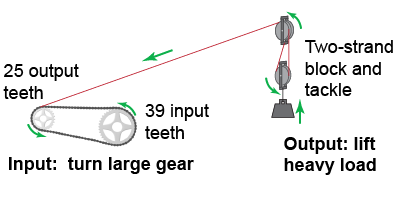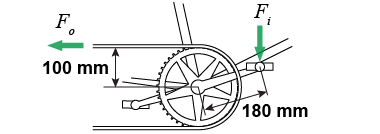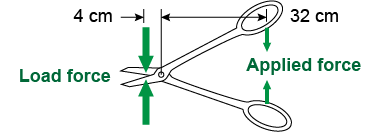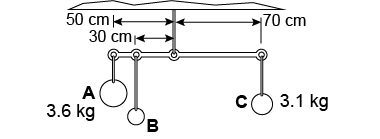- Conceptually speaking, how can you change a ramp into a wedge? Into a screw? What do the three devices have in common in terms of mechanical advantage?
- Tricia is building a birdhouse and having trouble driving a screw into the wood. Which of the following would make this task easier? (She has to do it by hand and can only deliver a certain amount of force to her screwdriver.)
- a screwdriver with a thicker handle
- a screw with more threads per inch
- both a and b
- neither a nor b
 A wedge is useful for splitting wood because it exhibits mechanical advantage, which increases whatever force you can deliver. Suppose that your hammer strikes a wedge with a force of 100 N, and the wedge splits a wooden block in two. Suppose too that the wedge pushed the two halves of the block apart from each other with 1,000 N of force. Explain why this does not violate any conservation laws. A wedge is useful for splitting wood because it exhibits mechanical advantage, which increases whatever force you can deliver. Suppose that your hammer strikes a wedge with a force of 100 N, and the wedge splits a wooden block in two. Suppose too that the wedge pushed the two halves of the block apart from each other with 1,000 N of force. Explain why this does not violate any conservation laws.
- The mechanical advantage (MA) of a compound machine is the _______ of the MAs of the individual machines.

 The compound machine shown here uses a bicyclist to turn a large gear, which turns a smaller gear (with fewer teeth). The smaller gear pulls a cord that uses a block and tackle to lift a heavy load. Which of the following changes will increase the mechanical advantage of this compound machine? (More than one answer may be correct. Note that the number of teeth is proportional to the gear radius, because the gears share a common chain.) The compound machine shown here uses a bicyclist to turn a large gear, which turns a smaller gear (with fewer teeth). The smaller gear pulls a cord that uses a block and tackle to lift a heavy load. Which of the following changes will increase the mechanical advantage of this compound machine? (More than one answer may be correct. Note that the number of teeth is proportional to the gear radius, because the gears share a common chain.) - increasing the radius (and therefore the number of teeth) of the large gear
- increasing the radius (and therefore number of teeth) of the small gear
- using a block and tackle with a mechanical advantage of three
- replacing the block and tackle with a simple pulley that hangs above the load
| |

- The diagram shows the arrangement of a bicycle crank and pedals. How much force is transmitted to the chain if 500 N of force is applied to the pedal? What is the mechanical advantage of the crank–chain machine?

- Shears are special scissors for cutting metal. Calculate the mechanical advantage of the shears shown in the diagram. If 30 lb of force is applied to the handles, how much force is applied to the metal between the blades?
- Janelle has a machine with a mechanical advantage of 2.5. She inputs a force of 20 N. What is the output force?

 Sofia has placed a 30 kg mass on the end of a first-class lever. At the other end, she applies a 60 N force to balance the lever. What is the mechanical advantage of her lever? Sofia has placed a 30 kg mass on the end of a first-class lever. At the other end, she applies a 60 N force to balance the lever. What is the mechanical advantage of her lever?

 A lamp designer creates a ceiling fixture with three globes suspended from a rod. What should be the mass of globe B so that the fixture will balance and hang with the rod horizontally? A lamp designer creates a ceiling fixture with three globes suspended from a rod. What should be the mass of globe B so that the fixture will balance and hang with the rod horizontally?
 Stanley has placed a 50 kg weight at the end of a 4 m lever. How far should the fulcrum be from the weight so that he can lift the weight with only 49 N of force? Stanley has placed a 50 kg weight at the end of a 4 m lever. How far should the fulcrum be from the weight so that he can lift the weight with only 49 N of force?
|

